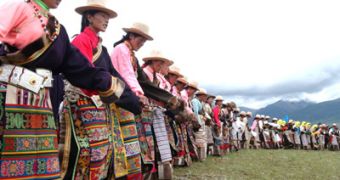You would get sick and disabled in the low oxygen conditions that are to be found at a hight of 14,763 feet (4,500 meters), which is the average altitude of the Tibetan Plateau. Yet, the Tibetans ruled empires from the 'roof' of the world.
Such heights have defeated many mountain climbers, as the shortage of oxygen into their lungs and blood during the ascend caused them nausea and dizziness, which often proved to be fatal in such conditions. A new research has solved the Tibetans' mystery: they possess broader arteries and capillaries transporting oxygen to their tissues.
"At the same time that [Tibetans] are extremely hypoxic at high altitude, they consume the same amount of oxygen that we do at sea level. One of the ways they do that is to have very high blood flow-delivering blood to tissue at twice the rate that we are." said anthropologist Cynthia Beall of Case Western Reserve University in Cleveland.
This increased blood flow is induced by higher quantities of nitric oxide in the linings of the blood vessels. This molecule generates into the blood nitrite and nitrate, inducing the swelling of the arteries and capillaries, which bear more rapidly oxygen to the tissues than normal.
The blood flow was assessed in the forearm, and Beall's team reported its findings in Proceedings of the National Academy of Sciences. The research was made on 88 Tibetan men and women, found to have a double blood flow than 50 Clevelanders, living in an area 675 ft (205 m) above sea level.
The team detected 10 times more nitric oxide in Tibetan blood, more than in patients with septic shock (a bacterial blood infection) and the blood flow of the Tibetans was similar to that of people with high blood pressure, without the harmful effects in Tibetans. "We don't see an increase in vascular resistance," said Beall. The Tibetans' blood presented also an increased amount of antioxidants, aimed to make the body withstand the high level of nitric oxide, a free radical.
Another adaptation discovered by this team was that Tibetans have a higher breathing rate than people of the plains and even other highlanders do, just as the locals of the Andes of South America are known to have the largest human lungs. When Tibetans were asked to breathe pure oxygen, their heart rates dropped by 16 %.
The scientists wonder if these adaptations are a proof of evolutionary functional adaptation in a human population. "You have to identify the gene and identify the gene variants that are different. But it sure seems like a reasonable hypothesis at the moment." said Beall.
The Tibetans have been living in the area for about 20,000 years. "This is an example of adaptation to high-altitude hypoxia. Tibetans know they are special because they live at high altitude without getting sick." said Beall.

 14 DAY TRIAL //
14 DAY TRIAL //